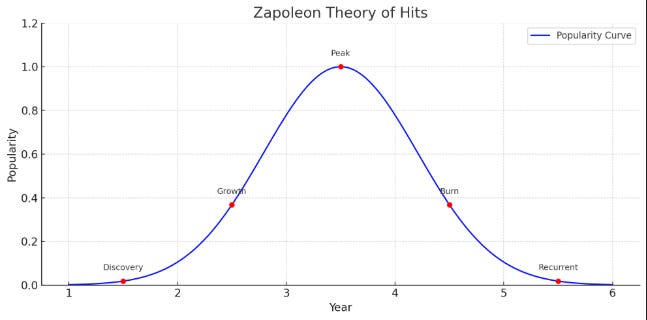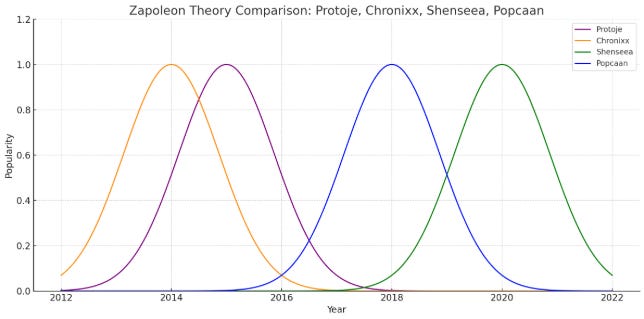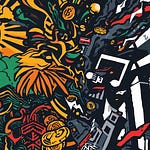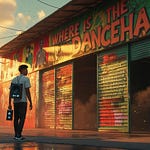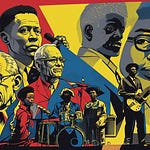Why do some songs explode overnight, dominate our playlists, then disappear only to resurface years later as timeless classics? The answer lies in the mysterious rhythm of musical discovery—and it's more predictable than you might think.
Ever wonder why that Chronixx track you discovered last year suddenly feels like a classic? Or why Shenseea's latest banger is everywhere you turn, but you know it won't stay that way forever?
Welcome to the Zapoleon Theory—a fascinating framework that maps the life cycle of music through five distinct phases over approximately seven years. Far from being just another industry buzzword, this theory offers profound insights into how reggae and dancehall music travels from underground circles to global consciousness and ultimately into the pantheon of classics.
The Five Phases of Musical Evolution
That's the Zapoleon Theory in action.
This fascinating framework maps music through 5 predictable phases over approximately 7 years—and the statistics reveal just how exclusive each level becomes:
Phase 1: Discovery/New
(27% of artists reach this stage)
The underground crucible where cultural tastemakers and early adopters first encounter magic. In reggae and dancehall, this happens in intimate spaces—small sound system sessions, local radio shows, or among tight-knit communities of music heads who pride themselves on discovering the next explosion before anyone else catches wind.
Phase 2: Growth/Rising Hit
(Only 10% of artists achieve this level)
The transition zone where niche becomes mainstream awareness. Social media algorithms begin their digital dance, streaming numbers start climbing, and radio DJs incorporate the track into their rotations. This is where organic discovery collides with the sophisticated machinery of modern music promotion.
Phase 3: Peak/Mass Appeal
(Just 5% of artists peak here)
Total cultural domination. The song becomes absolutely inescapable—thundering through clubs across continents, anchoring countless playlists, and soundtracking viral moments that define cultural conversations. Your grandmother and your youngest cousin both know every word.
Phase 4: Burn/Saturation
(Approximately 1% survive to this zone)
The inevitable fatigue factor kicks in. After months of ubiquitous exposure, listeners begin experiencing what psychologists call "habituation"—the novelty evaporates, and people start actively tuning out or avoiding what they once couldn't get enough of.
Phase 5: Recurrent/Gold
(The legendary few)
Where immortal classics are forged. No longer commanding heavy rotation, the song transcends into a different dimension of permanence. It becomes a nostalgic treasure that appears in throwback playlists and triggers powerful memories whenever those opening notes resurface from the depths of musical history.
Reggae & Dancehall Success Stories
The theory becomes crystal clear when we examine the trajectories of contemporary reggae and dancehall stars. Protoje's journey exemplifies the patient cultivation of an authentic underground following before breaking into wider consciousness. His roots-inspired approach initially resonated with reggae purists and conscious music fans, building a solid foundation that supported his eventual mainstream success.
Chronixx demonstrated how quickly an artist can move through the cycle when the music strikes the right chord at the right moment. His blend of traditional roots reggae with contemporary production and socially conscious lyrics created a perfect storm that propelled him from discovery to peak phases in record time.
Shenseea's meteoric rise in dancehall illustrates how the modern music landscape can accelerate the cycle. Her ability to craft catchy hooks while maintaining authentic dancehall energy has allowed her to cross cultural and geographical boundaries, taking Jamaican music to global audiences hungry for fresh sounds.
Popcaan represents the masterclass in cycle management. Having navigated from underground anthems to international collaborations, he's successfully positioned himself in that coveted "gold" zone where his music maintains cultural relevance across generations. His songs exist in a space where nostalgia meets timeless appeal.
The Digital Age Acceleration
What makes the Zapoleon Theory particularly relevant today is how digital platforms have both accelerated and complicated these traditional cycles. Streaming algorithms can catapult a song from discovery to peak phases in weeks rather than months. TikTok can resurrect tracks from the burn phase, giving them unexpected second lives. Meanwhile, the sheer volume of music being released means that more songs than ever are competing for attention in each phase.
For reggae and dancehall, genres deeply rooted in sound system culture and community-based discovery, this digital transformation presents both opportunities and challenges. The global reach is unprecedented, but the risk of cultural dilution or misrepresentation increases when music travels far from its origins.
Beyond Entertainment: A Strategic Framework
For artists and producers, understanding the Zapoleon Theory provides a strategic roadmap for career planning. Knowing that every song will likely follow this pattern helps in timing releases, managing marketing budgets, and maintaining long-term relevance. Smart artists don't just chase the peak phase—they build catalogs that can sustain them through the entire cycle.
The theory also explains why some artists who seemed to disappear after their peak moment often reemerge years later with surprising staying power. They were simply riding the wave into the gold phase, where different metrics of success—cultural impact, licensing opportunities, and nostalgic value—become more important than chart positions.
Cultural Preservation Through Cycles
Perhaps most importantly for reggae and dancehall, the Zapoleon Theory offers a framework for understanding how musical traditions survive and evolve. Each cycle doesn't just move individual songs through phases—it moves entire cultural expressions through generations of listeners. A Jamaican dancehall track that peaks globally doesn't just entertain; it plants seeds of cultural understanding that may not fully bloom until that song reaches its recurrent phase years later.
The theory reminds us that in our rush to embrace the newest sounds, we shouldn't underestimate the power of musical patience. Some of reggae and dancehall's most influential tracks weren't immediate hits—they were slow burns that found their audiences over time, eventually becoming foundational elements of the culture.
Riding the Wave
The next time you find yourself discovering a fresh reggae or dancehall track that gives you chills, remember that you're not just experiencing a moment of musical pleasure—you're participating in a predictable yet magical cycle that connects you to millions of other listeners across time and space.
That underground tune you're vibing to today might be the classic your children discover years from now, wondering why this "old" song feels so incredibly fresh.
The Zapoleon Theory doesn't diminish the mystery of musical discovery; it celebrates the beautiful predictability of how humans connect with rhythm, melody, and meaning. In a genre like reggae and dancehall, where the music carries messages of resistance, love, and celebration, understanding these cycles helps ensure that those messages continue reaching new generations of listeners ready to receive them.
As the digital age continues reshaping how we discover and consume music, the Zapoleon Theory serves as both a map and a reminder: every song has its season, every hit has its journey, and every classic was once just a discovery waiting to change someone's life.
The cycle continues, the music endures, and somewhere right now, the next timeless reggae or dancehall anthem is beginning its seven-year journey from underground gem to eternal gold.



